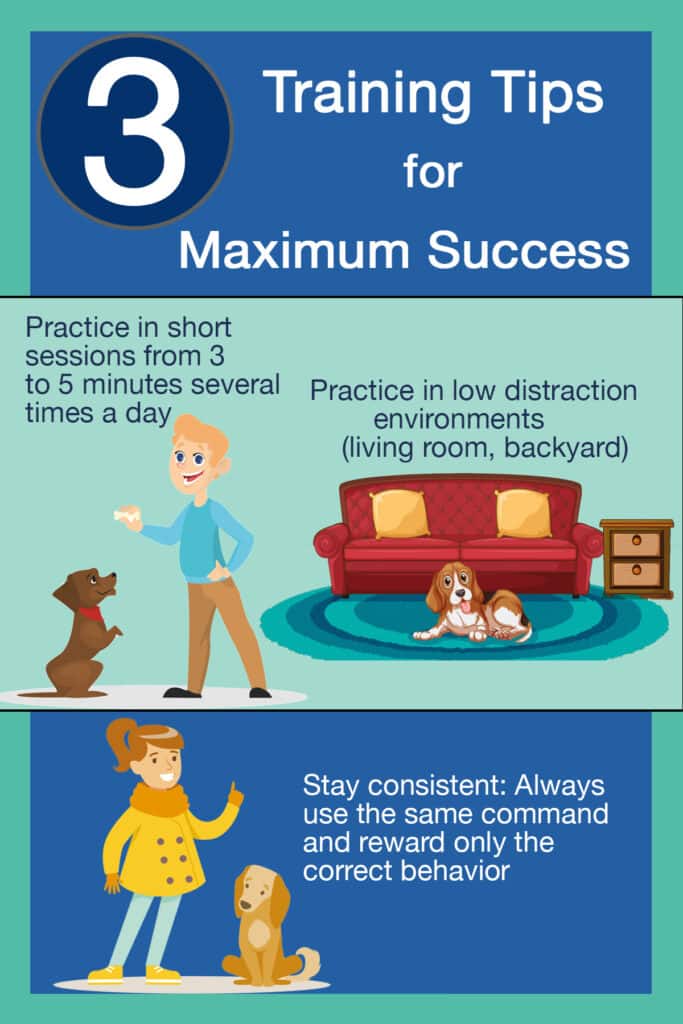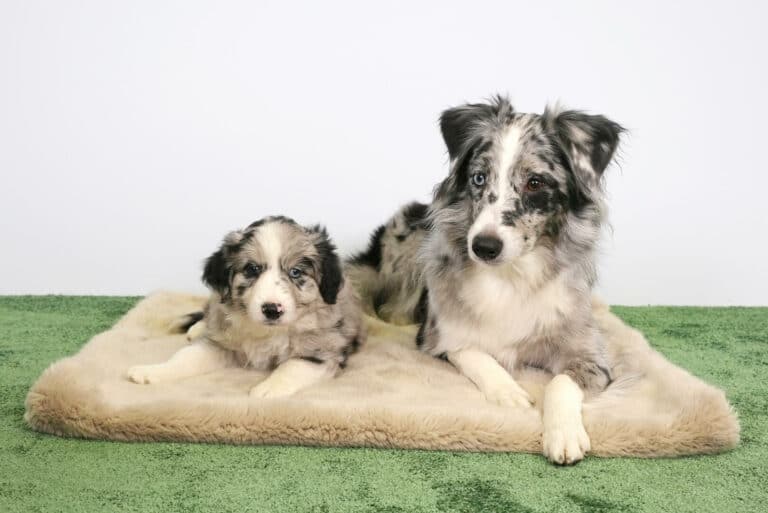How to Teach Your Dog to Lie Down in 3 Steps
- Anja Boecker
- Updated: 2023-05-31
One of the most important commands to teach your dog is "Down". Practicing basic commands is important for building a solid foundation for a happy and healthy relationship. With our expert tips, your dog will not only learn Sit quickly, but you'll both have a lot of fun doing it. Read on to learn more!

What is "Space"?
"Down" is a command that you can teach your dog. When you tell your dog to lie down, you want him to lie down and stay there. It is a useful command that can help you give your dog security, make him feel calm, and signal to him that there will be no "action" in this situation, such as when you are in a coffee shop or when you have visitors at home.
Why Every Dog Should Know How to Lie Down on Command
It is important that your dog can lie down and stay down on command - for example, when the doorbell rings and you want to greet your visitor in peace. Or when you are in a restaurant and want your dog to lie down under the table while you enjoy your meal.
It's also helpful to have a place for your dog to lie down on public transportation. If you're out and about and your dog is off leash, a reliable "Down!" from a distance can be helpful if your dog approaches a road or encounters a cyclist.
Teaching your dog the "Down" command takes some preparation, but once your pet masters it, you'll both feel more confident in everyday life. It's easy with a few simple tricks.
3-Step Guide To "Down"

We have created a simple step-by-step guide and helpful tips to help you get started quickly.
1) Guide Your Dog With Treats
Coming down from a sit is easier for the dog than coming down from a stand. Therefore, it is an advantage if your dog has already mastered this command. Hold a treat in front of your dog's nose. As soon as he focuses on it, bring it close to his body and then use the treat to guide your dog to the down position. Say "down" at the same time. It's important to go slowly. Your dog will follow the treat with his head and try to reach it with his snout. Eventually, he will lie down. Now you need to react quickly and reinforce the desired behavior! Release the treat, let your dog eat, and give him plenty of praise.
2) Release Correctly
Your dog may want to sit up immediately. However, it is important that he stays down as long as you tell him to. To motivate him to stay down, you can offer him a second or third treat. This will extend the time he spends on the floor. Then release your dog from the "down" position with an "okay" or "go". Play with him to show him that he can move freely again. You can increase the time on the floor with each repetition.
3) Add a Hand Signal
You can also combine the sit command with a hand signal. After some practice, your dog will be able to sit on the hand signal without you saying a word. To do this, point at the floor with the flat of your hand that is not holding the treat. At the same time, say the command "sit" in a clear voice. Your dog will soon associate the hand signal with the audible "sit" signal. Watch the timing! Reward your dog with a treat as soon as he lies down.
“Square” for Advanced Users
1) Repetition:
Practice this command a few times until your dog lies down on your command without you having to lead him. Don't forget to reward him every time he does it correctly.
2) Increase the Distance:
Once your dog has mastered this command, you can begin to increase the distance between you. Give the command "Sit" while taking a step or two away from him. Don't forget to reward him when he does it correctly.
3) Add Distractions:
Once your dog is comfortable with the command at a distance, you can begin to add distractions. You can try the command in a noisy environment or while playing with other dogs. This is an advanced practice to increase the reliability of the command.
4) Increase the Duration:
Finally, you can increase the amount of time your dog stays down after the "Sit" command. Start with a few seconds and slowly increase the time. Reward your dog for staying down until you release him.
This process requires patience and consistency, but in time you will find that your dog will obey the "down" command even in difficult situations. Good luck with your training!
Alternative Exercises
Clicker Training: This method uses a clicker, a small device that emits a distinct clicking sound. You click each time your dog performs the desired behavior, in this case lying down. Then you immediately give him a reward. Over time, your dog will learn that the click means he did something right.
Shapes: In this method, the desired behavior is formed step by step. First, reward your dog for small steps in the right direction, such as sitting down, then beginning to lie down, and finally lying down completely.
Capture: In this method, wait for your dog to lie down on his own and then reward him immediately. You can add the word "sit" when he lies down regularly.
Leg Bridge: If your dog won't lie down after several attempts, use your leg to create a "bridge" and walk your dog underneath to get him to lie down. Be careful not to force your dog to lie down: the tunnel should only let your dog know that the space is too small for him to stand. Again, use your command "down" as soon as your dog's chest and belly touch the ground.
It may be helpful to try different methods to see what works best for your dog. Remember that patience and consistency are the keys to success. Every dog learns at his own pace, so be patient and happy with any progress.
Too theoretical for you? If you prefer a visual approach, our app offers step-by-step video instructions to help you teach your dog "Down". Learn more about our app here.
Remember:

5 Reasons Your Dog Won't Lie Down and How to Address Them
Your dog just won't lie down? This can be frustrating for both of you. But don't worry, you're not alone! We'll give you the most common reasons why your dog won't lie down and how to handle the situation.
Comprehension Difficulties: Your dog may simply not understand what you want him to do. In this case, go slowly and repeat a previous step if necessary. Be careful not to overwhelm your dog. Just like people, dogs learn at different rates.
Distraction: The kids are running around the living room, the neighbor's dog is barking, and lunch is cooking on the stove? Smells, noises and hectic movements can disrupt your dog's concentration. Train in a low-stimulus, familiar environment and make sure your dog is rested and not thirsty or hungry.
Physical Discomfort: If the floor is very hard, cold, or hot, your dog may be reluctant to lie down. This is especially common if your dog is older and his bones and joints are more sensitive. Check the temperature of the floor with your hand and place a mat or thin pillow underneath if necessary. You can also practice on a rug.
Fear or Anxiety: When we are lying down, we are all vulnerable and unwilling to fight. For your dog to be so vulnerable, he needs to trust you and be reassured that there is no danger. Create a calm environment, move alertly, and exude calm so your dog knows everything is okay. If your dog is generally very anxious, consider working with a professional dog trainer to get to the root of the problem.
Lack of Motivation: Your boss pays you a commission for every contract you close? You get lots of compliments when you wear your new outfit? When our behavior has consequences that we perceive as positive, we are much more likely to behave that way in the future. The same goes for your dog. The best way to motivate him is through positive reinforcement. Reward your dog when he performs a desired behavior, rather than punishing him when he does something wrong. You can use treats, toys, or petting. Try different rewards to see what your dog likes best.
Difference between Relaxed "Down" and Tense "Down"
Your dog's body language can tell you a lot about how he's feeling. Here are some clues that can help you tell the difference between a relaxed and a tense "Down":
Relaxed "Down":
- Your dog is lying on his side or back. These are very relaxed positions that show your dog is safe and comfortable.
- His muscles are relaxed and his body looks relaxed.
- His tail is still or slowly wagging.
- His eyes are half closed or he is blinking slowly. He could even be sleeping!
- His ears are in a neutral or relaxed position, not laid back or forward.
Tense "Down":
- The dog lies on its belly, paws under its body, ready to jump up quickly.
- His muscles are tense and his body looks stiff.
- The tail is caught between the legs or moves jerkily.
- His eyes are wide open and he may be staring intently at something. The whites of the eyes may be visible, which is often called "walleye".
- The ears are laid back or stiffly forward.
- Frequent or heavy panting, often a sign of stress or anxiety.
It is important to note that not all dogs have the same body language. What looks relaxed to one dog may look tense to another. That's why it's important to watch your dog closely and learn his individual cues. If you find that your dog is tense when you say "down," it may help to change the situation to calm him down.
Teach Puppy “Down”:

Puppies generally learn in the same way as adult dogs, but there are some differences to be aware of. Puppies often have shorter attention spans and are more easily distracted. Therefore, training sessions should be short (5-10 minutes) and positive.
Always be patient and positive. Puppies are still very young and learning, so don't expect them to be perfect right away. Instead, focus on helping your puppy see training as a fun and positive experience.
Frequently Asked Questions
Have your dog sit and show him a treat. Give the command and slowly bring the treat to the ground and forward. Your puppy will follow with his nose and lie down. Reward them with the treat. See our article for detailed instructions.
Make sure your dog is relaxed but not overtired. Train several times a day in short sessions of a few minutes each. Create an environment without distractions from other people or dogs. Speak clearly and use body language. Don't forget to praise your dog often and reward him with toys or treats. Don't make your dog wait too long for a command, especially on wet, cold ground or hot asphalt. Training should be fun for your dog!
Once your dog is accustomed to staying in the start position while you stand beside him, you can slowly move away. Take a step back and come right back to praise and reward him. Slowly increase the distance between you and your dog, and don't forget to continue to praise and reward him for staying in the position to reinforce his behavior.
The choice of cue or command often depends on personal preference. In Germany, the word "Platz" is often used, while in English-speaking countries "Down" is often used.
It's important that the command you choose is unique and doesn't sound too similar to other commands to avoid confusion.
It is important that you stick with the command once chosen and use it consistently. Do not switch between different commands, this can confuse your dog.
The tone of your voice and the way you say the command can also have an effect. Try to give the command in a calm and clear tone of voice and avoid yelling at your dog or giving the command in a questioning tone of voice.
No matter what word you choose, with patience, practice and consistent use, your dog will learn what the command means and how to respond to it.
Whether you train the auditory or visual signal first depends on your personal preference and your dog's needs. Some dogs respond better to visual cues, while others respond better to auditory cues. However, it is common to train the auditory signal first and then add the visual signal.
Conclusion
By teaching your dog to lie down, you can benefit from his cooperation in many everyday situations. With a little practice and patience, your pet will quickly learn the command and be happy to lie down. Whether you want to chat with your neighbor, eat an ice cream cone, or safely ride the train with your dog, the "Down" command will keep you in control and your dog will know exactly what is expected of him.
Finally, we have a few tips for you:
- Consistency is important, but never force your dog to lie down. They learn best when you teach them through play!
- Train several times a day in short sessions – practice makes perfect!
- Take into account the amount of treats you used in your training and subtract that amount of food from their next meal or daily ration.
- End training with a sense of accomplishment for your pet.
Share Now:

My name is Anja Boecker, and I am a certified dog trainer and behavior consultant. With these articles, I want to help you to understand your dog better and to build an inseparable bond.

